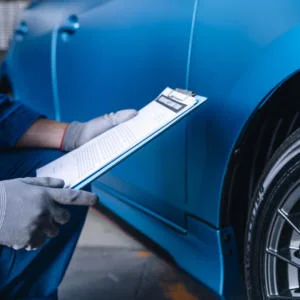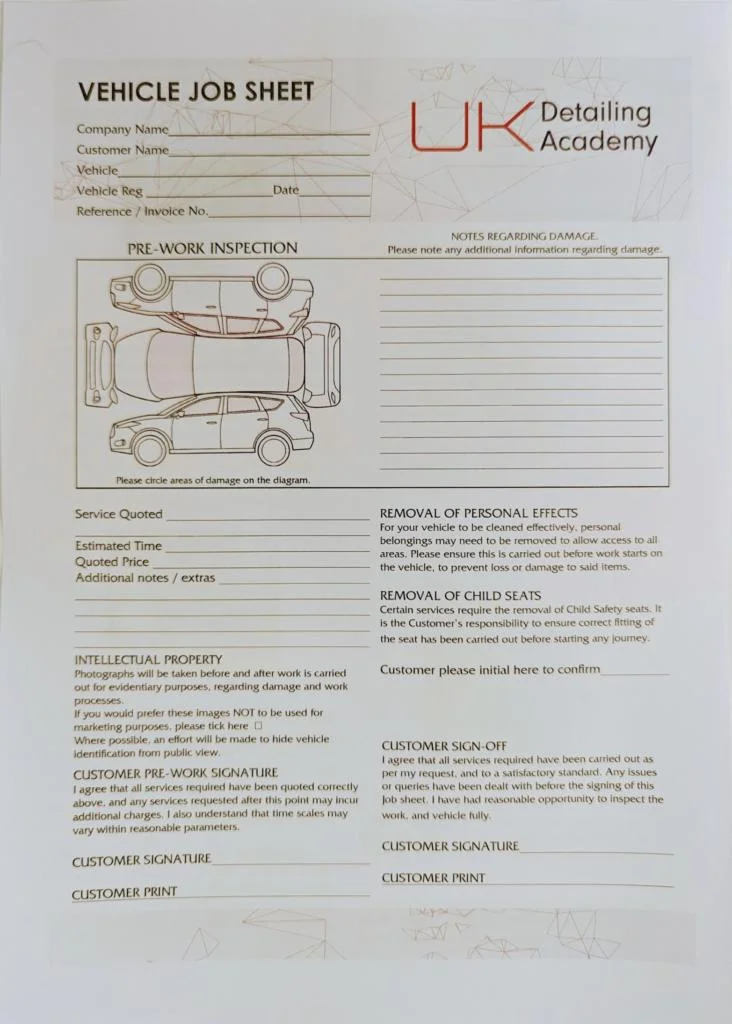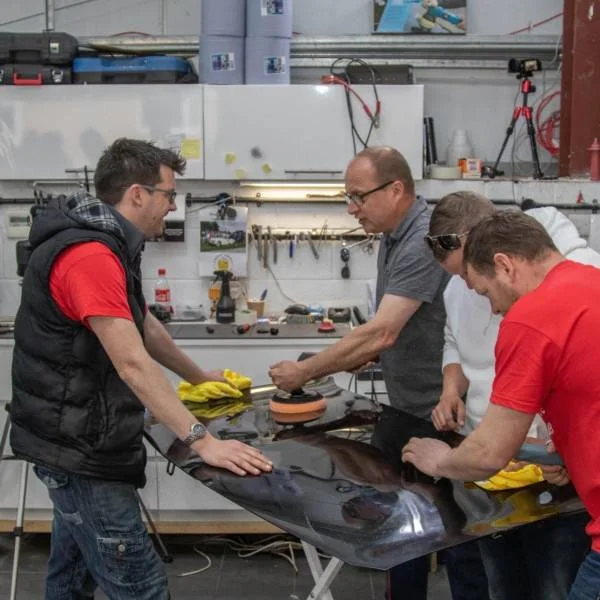
![]()
Pre work inspection forms are beneficial bits of paper for a detailing business to take advantage of.
They set out work to be completed, highlight existing damage or faults with a vehicle, highlight conditions and terms a customer may need to be aware of and serve a record of work being satisfactorily completed. In 99% of cases, once completed, you won’t need to refer to these bits of paper ever again. But that 1%…
Here’s a scenario encountered by Justin from “Frankie Valet’s 4 Season Cleaning”
Justin completed a valet one week ago for a client on their BMW X5.
He has just received a text message with the following complaints:
——-
Hi Justin,
I’ve just noticed a deep scratch down one side of my car. We’ve barely used the car since you cleaned it, so it must have been something you did.
Also, my child seat wasn’t fixed-in properly and my youngest tipped sideways when I went around a roundabout.
I think we need to come to some sort of compensation agreement before I take this to my solicitor.
Karen.
——-
Now, without that bit of paper, unless Justin has taken photos, it’s very much a “your word against theirs” on the damage, and unless you can offer any proof it’s 50/50 which way a court would go, so often easier just to let insurers handle it.
As for the child seat issue; whilst you may have asked the owner to check its fitting after removing it to clean – maybe as you were packing up or walking around the car – it is your responsibility unless stated otherwise.
However…
Justin has a pre-work inspection form!!!
This means his response can be as follows:
——-
Hi Karen, I’m sorry to hear about the trouble you’ve been having.
I’ll note that all queries regarding a completed job must be submitted within 24 hours, as per the signed conditions on the pre-work inspection form, as over a week later I cannot be assured that issues arisen are as a result of the work completed – I do have the mileage recorded however, so do inform me of that and if it matches up I’m more than happy to come down and compare the notes I have with the current condition.
Having reviewed the signed pre-work inspection form, I can see a deep scratch noted on the side of the vehicle and marked as “will need heavy correction to rectify”. Unfortunately, these areas do become more obvious after a car is thoroughly cleaned, and with your signature on the form you would have been alerted to this at the time, declaring yourself satisfied with the completed job.
In another section on the form, it does clearly state that child seats are not reinstalled, but placed on the seat upside down. This is due to all combinations being slightly different and not having personal training or instructions in all particular seats, it is best left to the owner to ensure safe installation. Therefore it may have been installed incorrectly – but not by myself.
If you wish to involve solicitors, please inform them in advance of the signed records kept to save yourself unnecessary expenses.
Love and hugs, Justin
——-
So, with the backup of a signed piece of paper, Justin has saved himself a potential repair cost, a child endangerment charge, retained his indemnity and silenced a lawsuit.
Neat, huh…
So what does this magic form need to contain?

You’ll need to adapt this to your business – maybe you work primarily on bikes or classic cars, so you have specifics in mind, but in general:
Date, time, mileage, vehicle reg, customer name – the basics of “who, what and when”
Vehicle condition and damage – Worth highlighting that if a vehicle is extremely dirty that not all defects will be apparent, but check the usual knock zones such as wheels, corners and bumpers, and look for hedge scratches. Mark for heavy stone chipping on the bonnet, and if you see colour variations, note it as a bad smart repair can turn into a nightmare.
Service Quoted – What have you been asked to do? If the job is a wash and wax, but the customer comes back claiming they were sold a full correction for £80, if it’s not in writing you’re on to a them vs. you scenario again.
Quoted price – So it’s clear from the outset what a job will cost – especially if you’ve arrived and had to re-quote due to extra work required.
Information statements – Anything you need to have a record of informing the customer and gaining consent if needed. This could include;
Intellectual Property – like putting your work on your website or social media? Get their consent in writing. Most won’t mind, but some have genuine reasons to object.
Touching their stuff – ask that anything loose is removed from the vehicle, this includes personal items, clothing and any cash or valuables which may be in the vehicle – if you’ve asked for it to be removed and they can’t find it afterwards (especially valuables such as money or earrings if it gets sucked up into a vacuum cleaner) you’ve given them the opportunity to head off the issue, and absolved yourself of technical responsibility.
Disclaimers – for us, the big one here is child seats. We always advise removing them to clean underneath fully – even cleaning the child seat itself – but leave the responsibility of reinstalling to the owner and replacing the seat in an obviously incorrect fashion, such as upside down – so that they have to install them properly themselves. They know how it fits, and you don’t want the accusation of endangering occupants on the off chance you fit it incorrectly. This could extend to rear seat screens, seatbelt guides, or anything that requires correct fitting and could be damaged if fitted incorrectly.
Pre-work Signature – there’s no point in marking damage before you start, then telling them after you’ve finished. A signature at this point accepts the discovered damage, confirms the work you’re about to do and the price they’ll pay, and allows you to snap away as you go.
Completion Signature – Once the work is complete, get a final signature to confirm that the work is completed to customer satisfaction and that they have inspected the vehicle thoroughly. Highlight any added notes such as damage discovered during the job and have them initial any amendments. Any additional terms, or a box tick to acknowledge their existence can be useful here too.
Additional steps:
Photos. Regardless if the customer allows you to use them for marketing purposes, ALWAYS take photos before and after a job. Four corners including wheels in each, a picture of the inside from both sides, and any areas you are working on such as an engine bay or boot area.
Photograph noted damage as this will not only give you evidence of it at the time but also a timestamp of when it was noted. Take pictures pre and post-work and keep them on your phone for a couple of months, just in case.
Anything else:
Do I have to give the customer a copy? Not necessarily. You can get duplicate books made up to order which will make it convenient to do that, but they can be expensive for customised low-quantity orders.
You can always offer to scan and send a digital copy if they want a record of it, with plenty of free phone apps capable of converting physical documents to PDF with a camera. If a customer has their own copy they can’t claim you have then edited it after the fact. If you make a digital copy, keep that and you can destroy the original, but store them somewhere digitally secure as GDPR can come into play.
Summary
Work inspection forms, like insurance, safety data sheets, first aid kits and risk assessments, are important details for a business that you hope you’ll never need, but you’ll be glad you had them if you do. They add a professional touch to a service and give customers clarity and confidence in your work, and can be a business saver if you’re ever accused of causing damage, misquoting a job or being deemed negligible in any way.
We supply templates for all these paperwork elements and run through your own setup as part of our Level 1 Career Development course for just that reason.
![]()

